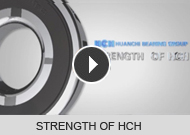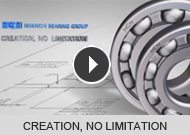
In addition to the basic requirements on a bearing like load capacity, speed limit and life time; low noise and vibration is becoming more and more important in most applicatons. Vibrations in bearings are caused by time varying forces in bearings. The contact forces move around the bearing, giving rise to perfect bearing vibrations in the outer ring. It is wellknown that excecssive vibrations can cause premature failure and costly maintenance, often including unplanned downtime and loss of production. High vibration levels also increase energy consumption. High noise levels, in turn, result in apoorer life environment for personnel and family. Therefore, to find out the roof causes of noise & vibration and prevent potential from the beginning is critical to perfect performance of the bearings.

Vibration Rising and Countermeasures
HCH is making 100% such noise and vibration testing before every single bearing leaves the factory. Also, HCH has recently significantly improved design of deep groove ball bearings, to further reduce noise and vibration levels.
Customers need to pay attention when coming across the following conditions.
| Types | Description | Causes | Countermeasures |
| Self-Generated Vibration | Vibration generated from the bearing itself when it is in the rotating condition. | Variations of circular form in the bearing balls and raceway. | Can not be avoided, but could reduce the vibration level by selecting the proper clearance due to the application. |
|
Vibration Arising from Exposure to External |
Disturbed noises occur with the performance degrades of bearings in modes known as wear oxidation or fretting corrosion. | The contaminated surrounding environment affects bearing. Loaded bearings operate without sufficient lubrication. | These conditions can be relieved by properly designed solation supports and adequate lubrication. |
|
Vibration from Misalignment |
Not well-aligned bearings make noise when they are rotating. |
Bearings are not well aligned on the shafts or houses during installation. The shafts and houses are not accurate. |
Good alignment methods and special alignment tools to reduce vibration. Applying high accuracy shafts and houses. |
| Local Damage Vibration | The small damaged sections on the raceways and rolling elements generate a specific vibration frequency. |
Mishandling or incorrect mounting. |
Applying correct mounting methods and mechanical tools such as fitting tools. Applying induction heaters with time control and preset temperature mode. |




